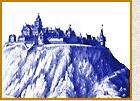 Friesach, one of the oldest towns of Austria, is located in the Alpine
region of northern Carinthia.
Friesach, one of the oldest towns of Austria, is located in the Alpine
region of northern Carinthia.
The surrounding area (called also the Hemmaland or country of Saint
Hemma) is characterized by the presence of not very high mountains and
of wide valleys known for the good quality of their cereals.
The monastery of the Domenican nuns in Friesach was the first to be
founded by this Order in the German speaking area in 1216.
The importance of the medioeval architecture is testified by many
fortresses, the main castle and the townwalls and by the presence of two
highly different but harmonized edifices as the Fürstenhof (Prince
residence) and the Getreiderspeicher (grain silo).
The numerous military and religious buildings document the strategic
interest of this old outpost of the Salzburg Archbischops located
between the Mur Valley and the main Carinthian town of Klagenfurt, in
the key-passage between Vienna and Venice.
Carinthia was a Dukedom at
the end of Xth century, it belonged to various noble families including
the Ottocarus from Boemia (XIIIth cent.), and finally in 1335 became
part of the Habsburg domain under the rule of Albert II° the Sage. A
part was annexed to the Napoleon province of Illiria from 1809 to
1814. After the first world war the Tarvisio area was annexed to
Italy, whereas the southern districts became part of Jugoslavia in
1919. The major portion of Carinthia including Klagenfurt and Friesach
remained Austrian according to the plebiscite of 1920.
We describe the history of Friesach up to 1335 because in this
period, prior to the Habsburg sovereignety, the bulk of the famous
Friesach coins was made.
From 796 to 828 Carinthia and Friesach were joined to Friuli
and from 828 to 907 the region was ruled by Margraves. During the Holy
Roman Empire the title of Margrave (Count of a Mark) was given to the
German nobles who governed frontier areas. From 907 to 976 Friesach
was ruled by Arnolf, son of Carlomanno, by Heinrich I° (the Young,
Duke of Bavaria), and by Otto I° until 982. It was joined to Bavaria
up to 995. The subsequent chronology is shown in the table in the text.
The large above the town sited castle of Genersperg was the residence
of Archbischop and Archdiaconous of Friesach. Due to a dispute with
them Count Wilhelm, husband of Hemma, was forced to leave the town. He
was then killed in 1036 by Adalberone von Eppenstein the former Duke of
Carinthia. As a widow Hemma disposed of a large richness which she
used to found the Admont Monastery and raise the Church of Gurk which
was terminated in 1056, became the Bischop Residence in 1071 and later
hosted her tomb
.
In 1481 Tabesch von Tschernhor, commander of the troupes of Matthias,
King of Hungary, conquered the town. But in 1496, by night during a
guard change, Friesach was taken again by the Carinthians.
The coniage in Friesach was initiated in 1045 when the Archbischop of
Salzburg became the ruler of this town and of the right to coniage by
will of Countess Hemma. Since 1015 obtained Hemma the right of coniage
from Emperor Heinrich II°.
After the year 1230 there was a quick increase of the pfennigs.
In the early decades of XIIIth century a large number of pfennigs was
circulating in the adjoining regions of Italy (Friuli, Görz,
Aquileia, Venice), of ex-Jugoslavia (Slovenia, Slavonia, Dalmatia,
Croatia), of Hungary and of Rumania (Bihor County and Transylvania).
From about 28,000 Pfennigs found in 49 sites in Hungary 67.3 % of the
coins were made in Friesah, 19.8 % was from St.Veit, 2.0 % from Kamnik
in W Slovenia, 11.1 % from Krka valley, 3.9% from N Slovenia and 0.6%
from Aquileia.
In the text we present a small collection of Friesach’s pfennigs: they look
graceful notwithstanding their coniage simplicity.


 Friesach, one of the oldest towns of Austria, is located in the Alpine
region of northern Carinthia.
Friesach, one of the oldest towns of Austria, is located in the Alpine
region of northern Carinthia.